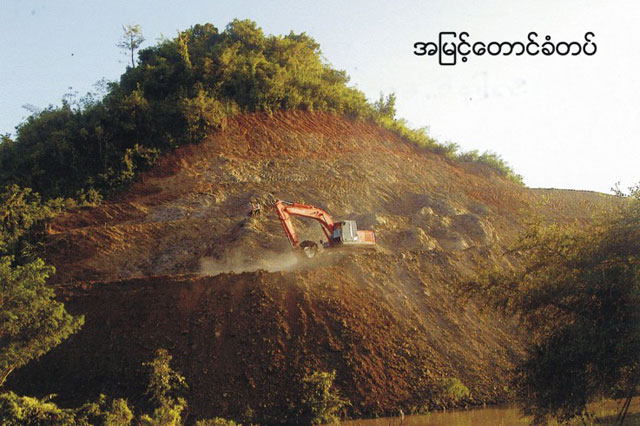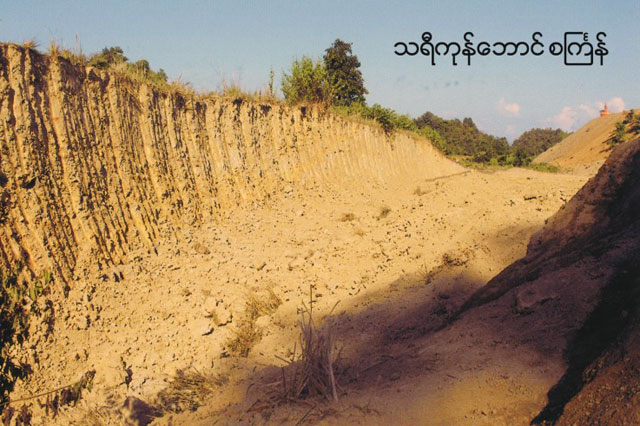Mrauk-U, the ancient capital city in northeastern Arakan State in Burma, is one of the most endangered cultural heritage sites in Asia, according to a report of the Global Heritage Fund.
 In its report titled “Asia’s Heritage in Peril: Saving Our Vanishing Heritage” that was released on 3 May, Global Heritage Fund has listed Mrauk-U, “Capital City of the First Arakanese Kingdom”, in its highlights of the ten most significant archaeological and heritage sites facing irreparable loss and destruction in Asia.
In its report titled “Asia’s Heritage in Peril: Saving Our Vanishing Heritage” that was released on 3 May, Global Heritage Fund has listed Mrauk-U, “Capital City of the First Arakanese Kingdom”, in its highlights of the ten most significant archaeological and heritage sites facing irreparable loss and destruction in Asia.
The report said those sites are being threatened by five accelerating man-made threats, including development pressure, unsustainable tourism, insufficient management, looting, and war and conflict.
The other sites listed in the report are Ayutthaya, the former Siamese capital in Thailand; Fort Santiago and Intramuros, the historic fortress in the Philippines; Kashgar, one the last intact silk road cities in China; Mahasthangarh, one of South Asia’s earliest urban archaeological sites in Bangladesh; Mes Aynak, an ancient Buddhist monastery complex on the Silk Road in Afghanistan; Plain of Jars, megalithic archaeological landscape with mysterious origins in Laos; Preah Vihear, picturesque masterpiece of Khmer architecture in Cambodia; Rakhigari, one of the largest and oldest Indus sites in the world in India; and Taxila, former crossroads of industry in the ancient Middle East in Pakistan.
When asked about the report and identification of Mrauk-U as one of the most endangered sites, U Kyaw Tun Aung, a retired archaeologist as well as a resident of Mrauk-U, made the following comments:
“The construction of the railroad through the main archaeological zone in Mrauk-U has destroyed many cultural and historic heritage in the city. The earthen city walls have been bulldozed for the earth to be in-fill in highway construction near the city. There are also big hotels being built within the zone and any well-wishers are allowed to restore or renovate the ancient pagodas or religious structures with in the zone as they like without regard for the original design of the structures. What is the ugliest is the bus stations are allowed to build within the palace site in the city. The destruction of archaeological heritage is increasing without an prevention or preservation because anyone can do whatever they wish in the city. That is why the city has become the most endangered site,” said U Kyaw Tun Aung.
He said many valuable heritage sites, including city walls and pagodas in the ancient cities of Danyawady and Vesali were also damaged as the railroad to connect Sittwe and Ann was constructed to cross through the middle of those cities last year.
U Tun Aung Kyaw also said that the cultural heritage in Mrauk-U is historically very important not only for the Arakanese but also for people around the world. “There are four prominent periods that began from 3325 BCE that are known as Danyawady, Vesali, Laymro, and Mrauk-U. All civilizations in the former periods converged in the Mrauk-U period and Mrauk-U emerged as the golden city with the vast stone-sculptured architecture that includes magnificent Buddha statues, stupas, and pagodas. Now Mrauk-U offers some of the richest archaeological sites in the world and it is very significant not only for the Arakanese but also people around the world,” said U Kyaw Tun Aung.
Mrauk-U, the last capital of the independent Arakanese kingdom, was founded by King Monn Saw Mon in 1430 CE. It was stable for over 300 years and it is now an ancient city rich in historical heritage.
U Kyaw Tun Aung, however, said that heritage has been destroyed by natural disasters as well as the lack of systematic preservation and maintenance.
 “There are still great weaknesses in the preservation and maintenance of our ancient historical heritage. That is why the ancient historic and cultural monuments have been ruined by natural disasters such as earthquakes, storms, and heavy rain. For example, the Shwegutaung Pagoda, the Barbutaung Pagoda, and Haritaung Pagoda collapsed during heavy rains. And there are also so many monuments being destroyed by creepers like the banyan trees,” he said.
“There are still great weaknesses in the preservation and maintenance of our ancient historical heritage. That is why the ancient historic and cultural monuments have been ruined by natural disasters such as earthquakes, storms, and heavy rain. For example, the Shwegutaung Pagoda, the Barbutaung Pagoda, and Haritaung Pagoda collapsed during heavy rains. And there are also so many monuments being destroyed by creepers like the banyan trees,” he said.
When asked how the archaeological department is working to prevent the damages of ancient cultural heritage sites, U Kyaw Tun Aung said, “When I was serving in the archeological department, there was yearly distribution of funds, but as the funds were so small and there were so many monuments, no preservation work could be properly done.”
To the question of how Mrauk-U could still be saved, he said, “There are archaeological zones recognized by the national government in Mrauk-U. Those zones should be protected exactly in line with the laws. There is also a need for systematic and scientific preservation of the heritage sites. It is also important to preserve the original design and structure while restoring or repairing damaged or deteriorating heritage sites. And then Mrauk-U will reach a curable situation from being endangered.”
There is widespread criticism among the local people that the successive Burmese regimes have not only abandoned the ancient cities of Arakan, including Mrauk-U, Danyawady, and Vesali without preservation, but extensively destroyed those city sites by constructing railroads and highway crossings through them under the guise of regional development.


